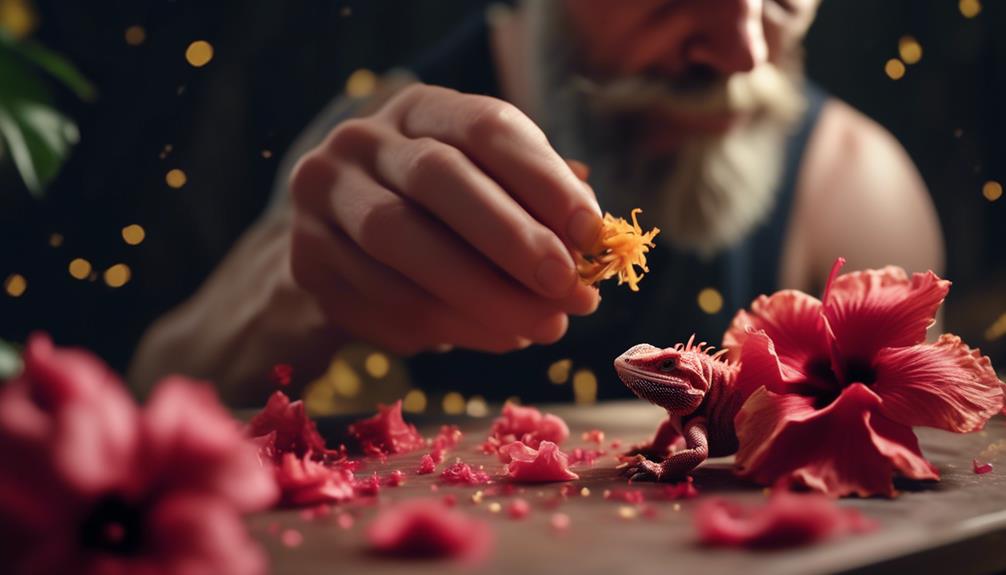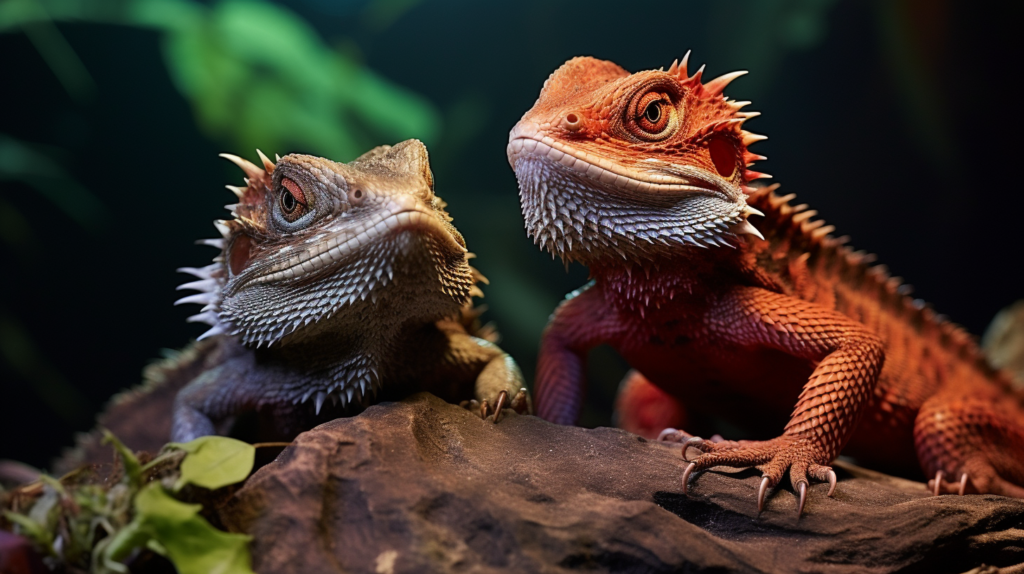You may have heard that hibiscus flowers can be a nutritious treat for your bearded dragon, but do you know how to properly prepare them?
It's important to ensure that the flowers are safe and beneficial for your pet before serving them.
In this discussion, we'll walk you through the steps of selecting, cleaning, and preparing hibiscus flowers for consumption by your bearded dragon.
By the end, you'll have a clear understanding of how to provide this colorful and healthy addition to your pet's diet.
Selecting Hibiscus Flowers
When selecting hibiscus flowers for your bearded dragon, search for vibrant, fresh blooms without any signs of wilting or discoloration. It's important to identify fresh hibiscus to ensure the nutritional value of the flowers. Fresh hibiscus flowers are known for their vivid, lively colors and turgid petals. Avoid flowers that seem wilted, dried out, or have browning edges as these may indicate a loss of nutrients.
Furthermore, examine the flowers for any indications of mold or pests, as these can be harmful to your bearded dragon.
Proper storage methods are crucial to preserve the freshness of hibiscus flowers. After choosing fresh blooms, store them in a cool, dry location to prevent moisture buildup, which can result in mold growth. Consider using an airtight container or a resealable bag to maintain the flowers' freshness for a longer period. Avoid placing them in direct sunlight or areas with high humidity, as these conditions can speed up wilting and spoilage.
Cleaning Hibiscus Flowers
When preparing hibiscus flowers for your bearded dragon, it's important to clean them thoroughly to ensure they're free from any dirt, debris, or potential contaminants. Start by gently rinsing the flowers under cool running water to remove any impurities. This step is crucial for maintaining the health benefits of the hibiscus flowers for your pet.
While cleaning the flowers, inspect them for any signs of pests or insects, and carefully remove them to prevent any harm to your bearded dragon. Additionally, trim off any discolored or damaged parts of the flowers, ensuring that only the freshest and healthiest parts are provided to your pet.
After rinsing, gently pat the flowers dry with a paper towel to remove excess water and prevent any potential mold growth. Once cleaned and dried, store the hibiscus flowers in a clean container to maintain their freshness and prevent contamination.
Removing Pollen and Pesticides
Once the hibiscus flowers for your bearded dragon are clean, it's important to address the potential presence of pollen and pesticides to ensure your pet's safety.
Pollen can pose health risks if ingested, so it's crucial to remove any residue. Shake the hibiscus flowers gently outdoors to dislodge any loose pollen, and then rinse them under running water to eliminate any remaining pollen and pesticides.
It's important to avoid using pesticides or chemicals on the flowers, as these can harm your bearded dragon. Consider sourcing hibiscus flowers from organic or pesticide-free sources, or use natural alternatives to remove potential pesticides, such as soaking the flowers in a water and vinegar mixture for a few minutes before thoroughly rinsing them.
These precautions and natural methods will help ensure that the hibiscus flowers are safe for your bearded dragon to consume.
Preparing Hibiscus Flowers for Consumption
Incorporating hibiscus flowers into your bearded dragon's diet involves a few simple steps to ensure they're prepared for consumption safely.
To prepare hibiscus flowers for your bearded dragon's consumption, follow these steps:
- Harvesting: Ensure the hibiscus flowers are free from pesticides and other chemicals by gathering them from a trusted organic source or your own pesticide-free garden.
- Cleaning: Thoroughly rinse the hibiscus flowers with water to eliminate any dirt, dust, or other contaminants. This step is crucial to prevent any unwanted substances from being consumed by your bearded dragon.
- Drying Process: After washing, allow the hibiscus flowers to air dry completely. This can be done by placing them on a clean paper towel or drying rack in a well-ventilated area. Proper drying helps prevent mold growth and ensures the flowers are in optimal condition for consumption.
- Nutritional Benefits: Hibiscus flowers are a great source of essential nutrients for your bearded dragon, including vitamins, minerals, and antioxidants. When properly prepared, these flowers can contribute to a balanced and healthy diet for your pet.
Serving Hibiscus Flowers to Your Bearded Dragon
When offering hibiscus flowers to your bearded dragon, it's important to do so in moderation to prevent potential digestive issues. Bearded dragons should have a diverse diet, so hibiscus flowers can be included as part of their feeding schedule, but they shouldn't dominate their meals. Start by offering small amounts of hibiscus flowers and monitor your bearded dragon's reaction. If there are no signs of digestive discomfort, you can gradually increase the quantity.
Hibiscus flowers provide a good source of hydration and essential vitamins and minerals such as vitamin C and antioxidants. They also contain calcium, which is crucial for maintaining strong bones and preventing metabolic bone disease in bearded dragons. However, it's essential to balance their diet with other suitable vegetables, fruits, and insects to ensure they receive a well-rounded nutritional intake.
Frequently Asked Questions
Can Bearded Dragons Eat All Types of Hibiscus Flowers, or Are There Specific Varieties That Are Safe for Them?
It's important to note that not all types of hibiscus flowers are suitable for bearded dragons. Certain varieties may be toxic to them. However, safe varieties like Hibiscus rosa-sinensis offer nutritional advantages and can be given to bearded dragons in moderation.
How Often Should Hibiscus Flowers Be Offered to Bearded Dragons as Part of Their Diet?
The frequency of offering hibiscus flowers to bearded dragons as part of their diet should be occasional, in order to provide dietary variety. It's important to tailor the preparation methods and serving size of the flowers to meet the bearded dragons' nutritional needs.
Are There Any Potential Side Effects or Health Risks Associated With Feeding Hibiscus Flowers to Bearded Dragons?
Feeding bearded dragons hibiscus flowers may pose potential risks and health effects. Some dragons could encounter digestive issues or allergic reactions. It's crucial to observe their reaction and seek advice from a vet if any worrisome symptoms arise.
Can Hibiscus Flowers Bearded Dragons Eat the Stems and Leaves as Well, or Should Only the Flowers Be Offered?
Yes, bearded dragons can consume hibiscus stems and leaves, although the flowers are the most nutrient-rich. Take into account their dietary preferences and include stems and leaves in their meal plan. However, be cautious of potential health hazards and utilize appropriate storage techniques.
Are There Any Alternative Ways to Prepare Hibiscus Flowers for Bearded Dragons, Such as Drying or Freezing Them, to Extend Their Shelf Life?
To prolong the shelf life of hibiscus flowers for bearded dragons, you can opt for a drying method. After drying, you can store them in an airtight container in a cool, dark place. This will help maintain their nutrients and enable you to provide them to your pet gradually.
Conclusion
Now that you have carefully prepared the hibiscus flowers for your bearded dragon, you can feel assured that you're offering them a nutritious and safe treat.
By taking the time to clean and eliminate any potential hazards, you're ensuring the well-being of your pet.
Your attention to detail and commitment to their care won't go unnoticed by your bearded dragon.


